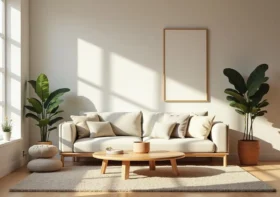Design That Sells: How Style Speeds Up Probate Home Sales

Selling a home is never just about square footage or zip code—it’s also about how a place feels when you walk in. That emotional first impression matters even more when the property is part of an estate sale. Probate homes, often passed down unexpectedly and sometimes left untouched for years, can be a harder sell unless some smart design choices come into play.
In many cases, the difference between a drawn-out sale and a quick close comes down to aesthetics. Thoughtful updates—without massive renovations—can transform a dated house into a space buyers get excited about. And when time, money, and family emotions are in the mix, a quick sale matters.
That’s where working with the right team like Unbiased options probate realtor, can help bridge that gap. They understand both the legal side of probate and the emotional nuance of preparing a loved one’s home for market, especially when design becomes part of the strategy.
Contents
- 1 Why Probate Homes Need a Visual Advantage
- 2 Staging Isn’t Just for Luxury Listings
- 3 Color Palettes That Speed Up Sales
- 4 Layout Tweaks That Make a Difference
- 5 Don’t Overlook the Entryway
- 6 Kitchen and Bath: Focus on Finish, Not Full Reno
- 7 Design Also Helps Tell a Story
- 8 What Buyers Notice (and What They Don’t)
- 9 Design Choices Can Speed Up Legal Processes Too
- 10 Final Thoughts: Style With Strategy
Why Probate Homes Need a Visual Advantage
Let’s be honest—probate homes aren’t always in the best shape to impress. Maybe the curtains haven’t been changed in decades, or the floral wallpaper felt charming once but now screams “tear me down.” These homes often have sentimental value but struggle to resonate with today’s buyers.
That’s why design is less about decoration and more about marketability. A home’s style can either spark imagination or stop interest in its tracks. Clean lines, neutral tones, and smart furniture placement can make even modest homes feel fresh, livable, and loved.
Probate homes compete with move-in-ready listings, so they need to show potential. The right design elements can make buyers think less about projects and more about possibilities.
Staging Isn’t Just for Luxury Listings
Some sellers think staging is a luxury reserved for high-end properties. Not true. Especially in probate cases, staging is a cost-effective way to shift buyer perception. Instead of seeing “Grandma’s old house,” buyers start seeing their future home.
Simple staging strategies that work:
- Remove excess furniture to create more space and flow.
- Use neutral tones for bedding, rugs, and throw pillows to appeal to broader tastes.
- Add greenery or flowers to brighten corners and soften hard lines.
- Use lighting intentionally—table lamps and warm bulbs make rooms feel cozy, not clinical.
Even just rearranging what’s already there can do wonders. A well-placed mirror can expand a hallway. Swapping out heavy drapes for sheers can pull in more natural light. These aren’t expensive changes, but they’re powerful.
Color Palettes That Speed Up Sales
Color psychology has a real effect on buyer behavior. You don’t have to repaint every room, but refreshing high-traffic spaces can do more than just make a place look clean—it can make it feel desirable.
Here’s what typically works:
- Soft grays and off-whites create a blank slate.
- Warm taupe or greige adds depth without being overwhelming.
- Pale blues or sage greens evoke calm, great for bedrooms or bathrooms.
- Consistent color themes throughout the house help it feel more cohesive.
Avoid bold or trendy colors unless you’re 100% sure they suit the architecture and intended buyer pool. Most people want to imagine their own style in a space, not feel like they have to repaint everything the minute they move in.
Layout Tweaks That Make a Difference
You can’t change the floor plan in a probate home, but you can change how it’s perceived. Buyers love open-concept living, but even if the house has formal rooms, the layout can be softened with strategic furniture choices.
Tips to improve flow:
- Float sofas and chairs away from walls to create conversation areas.
- Use rugs to define zones in open or awkwardly shaped rooms.
- Remove bulky furniture that disrupts movement or makes rooms feel smaller.
- Make sure there’s a clear path from the entryway to main living spaces.
When buyers can mentally map how they’d live in a space—from relaxing to entertaining—they’re more likely to act quickly.
Don’t Overlook the Entryway
First impressions count, and the front door is where they start. Whether buyers see the listing online or pull up to the curb, that initial glance matters.
Easy entry upgrades:
- A fresh coat of paint on the front door (black or navy often works well).
- Clean house numbers and a functional, attractive light fixture.
- Trimmed shrubs, swept walkways, and a seasonal planter.
If the home’s interior has been refreshed but the entryway feels neglected, the whole design story falls flat. This is especially true for probate homes where the rest of the exterior might feel worn. A little polish up front suggests care inside.
Kitchen and Bath: Focus on Finish, Not Full Reno
Probate sellers usually don’t want to gut a kitchen or install a new bathroom—and that’s totally fair. But small updates in these areas can still make a big impact.
Smart kitchen upgrades:
- Replace dated cabinet hardware with sleek, brushed finishes.
- Paint cabinets a fresh white or soft neutral.
- Add a peel-and-stick backsplash for a quick modern touch.
Easy bathroom refresh ideas:
- Replace old faucets and towel bars.
- Install a new mirror or vanity light.
- Use white shower curtains and fluffy towels for a spa-like vibe.
Buyers look at kitchens and baths with a critical eye, so even cosmetic updates can help the space feel less like a fixer-upper and more like a fresh opportunity.
Design Also Helps Tell a Story
Probate sales can be emotional. There’s a history in the home—sometimes decades long—and family members may struggle with the idea of “changing” anything. But updating design doesn’t erase the past; it helps open the door to a new chapter.
A thoughtfully staged home can still nod to its legacy without feeling stuck in time. Maybe there’s a framed vintage photo in the hallway or a few antique books on a shelf. These little touches help buyers feel a sense of warmth and depth—without making them feel like guests in someone else’s home.
What Buyers Notice (and What They Don’t)
You might think buyers will walk in and focus on the age of the furnace or the brand of kitchen appliances—but what they really notice first is feeling. Is the space clean, bright, and welcoming? Does it smell fresh? Does it feel spacious, even if it’s not large?
Here’s what catches buyer attention fast:
- Clean floors and dust-free surfaces
- Lots of natural light (or the appearance of it)
- Furniture scaled to room size
- Well-defined rooms with a clear purpose
- Absence of clutter
If a probate home is empty, consider light virtual staging to give online listings some character. A blank canvas can be hard for buyers to visualize—design helps connect the dots.
Design Choices Can Speed Up Legal Processes Too
It’s not just about selling faster—it’s about closing the loop on probate itself. When a property sells quickly, it can simplify the entire estate process. The proceeds can be distributed sooner, and the stress on family members (especially executors) gets reduced.
More importantly, design creates clarity. Buyers don’t linger in indecision when a space feels ready. And agents can market the home with confidence, knowing it will show well from the first open house to the final walk-through.
Final Thoughts: Style With Strategy
You don’t need to stage a probate home like a celebrity penthouse or remodel it from top to bottom. But you do need to think strategically about how it looks, feels, and flows.
Simple design upgrades—paired with a smart selling plan—can make the difference between a listing that lingers and one that sells with ease. If you’re unsure where to start, partnering with professionals who understand the probate process and buyer psychology can save a lot of guesswork—and potentially thousands of dollars.
The home’s story doesn’t end with probate. A little style can help turn the page.



